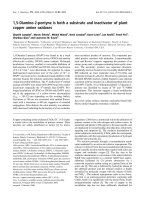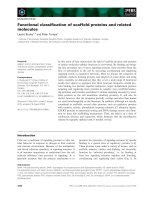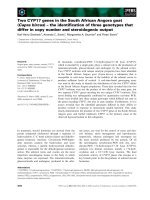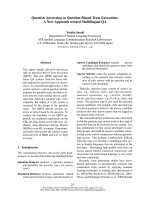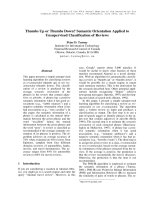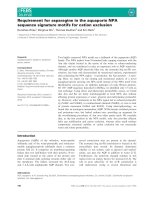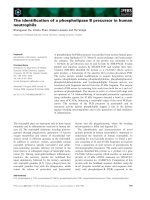Báo cáo khoa học: "Hedge classification in biomedical texts with a weakly supervised selection of keywords" doc
Bạn đang xem bản rút gọn của tài liệu. Xem và tải ngay bản đầy đủ của tài liệu tại đây (161.84 KB, 9 trang )
Proceedings of ACL-08: HLT, pages 281–289,
Columbus, Ohio, USA, June 2008.
c
2008 Association for Computational Linguistics
Hedge classification in biomedical texts with a weakly supervised selection of
keywords
Gy
¨
orgy Szarvas
Research Group on Artificial Intelligence
Hungarian Academy of Sciences / University of Szeged
HU-6720 Szeged, Hungary
Abstract
Since facts or statements in a hedge or negated
context typically appear as false positives, the
proper handling of these language phenomena
is of great importance in biomedical text min-
ing. In this paper we demonstrate the impor-
tance of hedge classification experimentally
in two real life scenarios, namely the ICD-
9-CM coding of radiology reports and gene
name Entity Extraction from scientific texts.
We analysed the major differences of specu-
lative language in these tasks and developed
a maxent-based solution for both the free text
and scientific text processing tasks. Based on
our results, we draw conclusions on the pos-
sible ways of tackling speculative language in
biomedical texts.
1 Introduction
The highly accurate identification of several regu-
larly occurring language phenomena like the specu-
lative use of language, negation and past tense (tem-
poral resolution) is a prerequisite for the efficient
processing of biomedical texts. In various natural
language processing tasks, relevant statements ap-
pearing in a speculative context are treated as false
positives. Hedge detection seeks to perform a kind
of semantic filtering of texts, that is it tries to sep-
arate factual statements from speculative/uncertain
ones.
1.1 Hedging in biomedical NLP
To demonstrate the detrimental effects of specula-
tive language on biomedical NLP tasks, we will con-
sider two inherently different sample tasks, namely
the ICD-9-CM coding of radiology records and gene
information extraction from biomedical scientific
texts. The general features of texts used in these
tasks differ significantly from each other, but both
tasks require the exclusion of uncertain (or specula-
tive) items from processing.
1.1.1 Gene Name and interaction extraction
from scientific texts
The test set of the hedge classification dataset
1
(Medlock and Briscoe, 2007) has also been anno-
tated for gene names
2
.
Examples of speculative assertions:
Thus, the D-mib wing phenotype may result from de-
fective N inductive signaling at the D-V boundary.
A similar role of Croquemort has not yet been tested,
but seems likely since the crq mutant used in this
study (crqKG01679) is lethal in pupae.
After an automatic parallelisation of the 2 annota-
tions (sentence matching) we found that a significant
part of the gene names mentioned (638 occurences
out of a total of 1968) appears in a speculative sen-
tence. This means that approximately 1 in every 3
genes should be excluded from the interaction detec-
tion process. These results suggest that a major por-
tion of system false positives could be due to hedg-
ing if hedge detection had been neglected by a gene
interaction extraction system.
1.1.2 ICD-9-CM coding of radiology records
Automating the assignment of ICD-9-CM codes
for radiology records was the subject of a shared task
1
/>∼
bwm23/
2
/>∼
nk304/
281
challenge organised in Spring 2007. The detailed
description of the task, and the challenge itself can
be found in (Pestian et al., 2007) and online
3
. ICD-
9-CM codes that are assigned to each report after
the patient’s clinical treatment are used for the reim-
bursement process by insurance companies. There
are official guidelines for coding radiology reports
(Moisio, 2006). These guidelines strictly state that
an uncertain diagnosis should never be coded, hence
identifying reports with a diagnosis in a specula-
tive context is an inevitable step in the development
of automated ICD-9-CM coding systems. The fol-
lowing examples illustrate a typical non-speculative
context where a given code should be added, and
a speculative context where the same code should
never be assigned to the report:
non-speculative: Subsegmental atelectasis in the
left lower lobe, otherwise normal exam.
speculative: Findings suggesting viral or reactive
airway disease with right lower lobe atelectasis or
pneumonia. In an ICD-9 coding system developed
for the challenge, the inclusion of a hedge classi-
fier module (a simple keyword-based lookup method
with 38 keywords) improved the overall system per-
formance from 79.7% to 89.3%.
1.2 Related work
Although a fair amount of literature on hedging in
scientific texts has been produced since the 1990s
(e.g. (Hyland, 1994)), speculative language from a
Natural Language Processing perspective has only
been studied in the past few years. This phe-
nomenon, together with others used to express forms
of authorial opinion, is often classified under the no-
tion of subjectivity (Wiebe et al., 2004), (Shana-
han et al., 2005). Previous studies (Light et al.,
2004) showed that the detection of hedging can be
solved effectively by looking for specific keywords
which imply that the content of a sentence is spec-
ulative and constructing simple expert rules that de-
scribe the circumstances of where and how a key-
word should appear. Another possibility is to treat
the problem as a classification task and train a sta-
tistical model to discriminate speculative and non-
speculative assertions. This approach requires the
availability of labeled instances to train the models
3
/>on. Riloff et al. (Riloff et al., 2003) applied boot-
strapping to recognise subjective noun keywords
and classify sentences as subjective or objective in
newswire texts. Medlock and Briscoe (Medlock and
Briscoe, 2007) proposed a weakly supervised setting
for hedge classification in scientific texts where the
aim is to minimise human supervision needed to ob-
tain an adequate amount of training data.
Here we follow (Medlock and Briscoe, 2007) and
treat the identification of speculative language as the
classification of sentences for either speculative or
non-speculative assertions, and extend their method-
ology in several ways. Thus given labeled sets S
spec
and S
nspec
the task is to train a model that, for each
sentence s, is capable of deciding whether a previ-
ously unseen s is speculative or not.
The contributions of this paper are the following:
• The construction of a complex feature selection
procedure which successfully reduces the num-
ber of keyword candidates without excluding
helpful keywords.
• We demonstrate that with a very limited
amount of expert supervision in finalising the
feature representation, it is possible to build ac-
curate hedge classifiers from (semi-) automati-
cally collected training data.
• The extension of the feature representation
used by previous works with bigrams and tri-
grams and an evaluation of the benefit of using
longer keywords in hedge classification.
• We annotated a small test corpora of biomed-
ical scientific papers from a different source
to demonstrate that hedge keywords are highly
task-specific and thus constructing models that
generalise well from one task to another is not
feasible without a noticeable loss in accuracy.
2 Methods
2.1 Feature space representation
Hedge classification can essentially be handled by
acquiring task specific keywords that trigger specu-
lative assertions more or less independently of each
other. As regards the nature of this task, a vector
space model (VSM) is a straightforward and suit-
able representation for statistical learning. As VSM
282
is inadequate for capturing the (possibly relevant) re-
lations between subsequent tokens, we decided to
extend the representation with bi- and trigrams of
words. We chose not to add any weighting of fea-
tures (by frequency or importance) and for the Max-
imum Entropy Model classifier we included binary
data about whether single features occurred in the
given context or not.
2.2 Probabilistic training data acquisition
To build our classifier models, we used the dataset
gathered and made available by (Medlock and
Briscoe, 2007). They commenced with the seed set
S
spec
gathered automatically (all sentences contain-
ing suggest or likely – two very good speculative
keywords), and S
nspec
that consisted of randomly
selected sentences from which the most probable
speculative instances were filtered out by a pattern
matching and manual supervision procedure. With
these seed sets they then performed the following
iterative method to enlarge the initial training sets,
adding examples to both classes from an unlabelled
pool of sentences called U :
1. Generate seed training data: S
spec
and S
nspec
2. Initialise: T
spec
← S
spec
and T
nspec
← S
nspec
3. Iterate:
• Train classifier using T
spec
and T
nspec
• Order U by P (spec) values assigned by
the classifier
• T
spec
← most probable batch
• T
nspec
← least probable batch
What makes this iterative method efficient is that,
as we said earlier, hedging is expressed via key-
words in natural language texts; and often several
keywords are present in a single sentence. The
seed set S
spec
contained either suggest or likely,
and due to the fact that other keywords cooccur
with these two in many sentences, they appeared
in S
spec
with reasonable frequency. For example,
P (spec|may) = 0.9985 on the seed sets created
by (Medlock and Briscoe, 2007). The iterative ex-
tension of the training sets for each class further
boosted this effect, and skewed the distribution of
speculative indicators as sentences containing them
were likely to be added to the extended training set
for the speculative class, and unlikely to fall into the
non-speculative set.
We should add here that the very same feature has
an inevitable, but very important side effect that is
detrimental to the classification accuracy of mod-
els trained on a dataset which has been obtained
this way. This side effect is that other words (often
common words or stopwords) that tend to cooccur
with hedge cues will also be subject to the same it-
erative distortion of their distribution in speculative
and non-speculative uses. Perhaps the best exam-
ple of this is the word it. Being a stopword in our
case, and having no relevance at all to speculative
assertions, it has a class conditional probability of
P (spec|it) = 74.67% on the seed sets. This is due
to the use of phrases like it suggests that, it is likely,
and so on. After the iterative extension of training
sets, the class-conditional probability of it dramati-
cally increased, to P (spec|it) = 94.32%. This is a
consequence of the frequent co-occurence of it with
meaningful hedge cues and the probabilistic model
used and happens with many other irrelevant terms
(not just stopwords). The automatic elimination of
these irrelevant candidates is one of our main goals
(to limit the number of candidates for manual con-
sideration and thus to reduce the human effort re-
quired to select meaningful hedge cues).
This shows that, in addition to the desired ef-
fect of introducing further speculative keywords and
biasing their distribution towards the speculative
class, this iterative process also introduces signifi-
cant noise into the dataset. This observation led us
to the conclusion that in order to build efficient clas-
sifiers based on this kind of dataset, we should fil-
ter out noise. In the next part we will present our
feature selection procedure (evaluated in the Results
section) which is capable of underranking irrelevant
keywords in the majority of cases.
2.3 Feature (or keyword) selection
To handle the inherent noise in the training dataset
that originates from its weakly supervised construc-
tion, we applied the following feature selection pro-
cedure. The main idea behind it is that it is unlikely
that more than two keywords are present in the text,
which are useful for deciding whether an instance is
speculative. Here we performed the following steps:
283
1. We ranked the features x by frequency and
their class conditional probability P (spec|x).
We then selected those features that had
P (spec|x) > 0.94 (this threshold was cho-
sen arbitrarily) and appeared in the training
dataset with reasonable frequency (frequency
above 10
−5
). This set constituted the 2407 can-
didates which we used in the second analysis
phase.
2. For trigrams, bigrams and unigrams – pro-
cessed separately – we calculated a new class-
conditional probability for each feature x, dis-
carding those observations of x in speculative
instances where x was not among the two high-
est ranked candidate. Negative credit was given
for all occurrences in non-speculative contexts.
We discarded any feature that became unreli-
able (i.e. any whose frequency dropped be-
low the threshold or the strict class-conditional
probability dropped below 0.94). We did this
separately for the uni-, bi- and trigrams to avoid
filtering out longer phrases because more fre-
quent, shorter candidates took the credit for all
their occurrences. In this step we filtered out
85% of all the keyword candidates and kept 362
uni-, bi-, and trigrams altogether.
3. In the next step we re-evaluated all 362 candi-
dates together and filtered out all phrases that
had a shorter and thus more frequent substring
of themselves among the features, with a sim-
ilar class-conditional probability on the specu-
lative class (worse by 2% at most). Here we
discarded a further 30% of the candidates and
kept 253 uni-, bi-, and trigrams altogether.
This efficient way of reranking and selecting po-
tentially relevant features (we managed to discard
89.5% of all the initial candidates automatically)
made it easier for us to manually validate the re-
maining keywords. This allowed us to incorporate
supervision into the learning model in the feature
representation stage, but keep the weakly supervised
modelling (with only 5 minutes of expert supervi-
sion required).
2.4 Maximum Entropy Classifier
Maximum Entropy Models (Berger et al., 1996)
seek to maximise the conditional probability of
classes, given certain observations (features). This
is performed by weighting features to maximise the
likelihood of data and, for each instance, decisions
are made based on features present at that point, thus
maxent classification is quite suitable for our pur-
poses. As feature weights are mutually estimated,
the maxent classifier is capable of taking feature de-
pendence into account. This is useful in cases like
the feature it being dependent on others when ob-
served in a speculative context. By downweighting
such features, maxent is capable of modelling to a
certain extent the special characteristics which arise
from the automatic or weakly supervised training
data acquisition procedure. We used the OpenNLP
maxent package, which is freely available
4
.
3 Results
In this section we will present our results for hedge
classification as a standalone task. In experiments
we made use of the hedge classification dataset of
scientific texts provided by (Medlock and Briscoe,
2007) and used a labeled dataset generated automat-
ically based on false positive predictions of an ICD-
9-CM coding system.
3.1 Results for hedge classification in
biomedical texts
As regards the degree of human intervention needed,
our classification and feature selection model falls
within the category of weakly supervised machine
learning. In the following sections we will evalu-
ate our above-mentioned contributions one by one,
describing their effects on feature space size (effi-
ciency in feature and noise filtering) and classifi-
cation accuracy. In order to compare our results
with Medlock and Briscoe’s results (Medlock and
Briscoe, 2007), we will always give the BEP (spec)
that they used – the break-even-point of precision
and recall
5
. We will also present F
β=1
(spec) values
4
/>5
It is the point on the precision-recall curve of spec class
where P = R. If an exact P = R cannot be realised due to
the equal ranking of many instances, we use the point closest
to P = R and set BEP (spec) = (P + R)/2. BEP is an
284
which show how good the models are at recognising
speculative assertions.
3.1.1 The effects of automatic feature selection
The method we proposed seems especially effec-
tive in the sense that we successfully reduced the
number of keyword candidates from an initial 2407
words having P (spec|x) > 0.94 to 253, which
is a reduction of almost 90%. During the pro-
cess, very few useful keywords were eliminated and
this indicated that our feature selection procedure
was capable of distinguishing useful keywords from
noise (i.e. keywords having a very high specula-
tive class-conditional probability due to the skewed
characteristics of the automatically gathered train-
ing dataset). The 2407-keyword model achieved a
BEP (spec) os 76.05% and F
β=1
(spec) of 73.61%,
while the model after feature selection performed
better, achieving a BEP (spec) score of 78.68%
and F
β=1
(spec) score of 78.09%. Simplifying the
model to predict a spec label each time a keyword
was present (by discarding those 29 features that
were too weak to predict spec alone) slightly in-
creased both the BEP (spec) and F
β=1
(spec) val-
ues to 78.95% and 78.25%. This shows that the
Maximum Entropy Model in this situation could
not learn any meaningful hypothesis from the cooc-
curence of individually weak keywords.
3.1.2 Improvements by manual feature
selection
After a dimension reduction via a strict reranking
of features, the resulting number of keyword candi-
dates allowed us to sort the retained phrases manu-
ally and discard clearly irrelevant ones. We judged
a phrase irrelevant if we could consider no situation
in which the phrase could be used to express hedg-
ing. Here 63 out of the 253 keywords retained by
the automatic selection were found to be potentially
relevant in hedge classification. All these features
were sufficient for predicting the spec class alone,
thus we again found that the learnt model reduced
to a single keyword-based decision.
6
These 63 key-
interesting metric as it demonstrates how well we can trade-off
precision for recall.
6
We kept the test set blind during the selection of relevant
keywords. This meant that some of them eventually proved to
be irrelevant, or even lowered the classification accuracy. Ex-
amples of such keywords were will, these data and hypothesis.
words yielded a classifier with a BEP (spec) score
of 82.02% and F
β=1
(spec) of 80.88%.
3.1.3 Results obtained adding external
dictionaries
In our final model we added the keywords used in
(Light et al., 2004) and those gathered for our ICD-
9-CM hedge detection module. Here we decided not
to check whether these keywords made sense in sci-
entific texts or not, but instead left this task to the
maximum entropy classifier, and added only those
keywords that were found reliable enough to predict
spec label alone by the maxent model trained on the
training dataset. These experiments confirmed that
hedge cues are indeed task specific – several cues
that were reliable in radiology reports proved to be
of no use for scientific texts. We managed to in-
crease the number of our features from 63 to 71 us-
ing these two external dictionaries.
These additional keywords helped us to increase
the overall coverage of the model. Our final hedge
classifier yielded a BEP (spec) score of 85.29%
and F
β=1
(spec) score of 85.08% (89.53% Preci-
sion, 81.05% Recall) for the speculative class. This
meant an overall classification accuracy of 92.97%.
Using this system as a pre-processing module for
a hypothetical gene interaction extraction system,
we found that our classifier successfully excluded
gene names mentioned in a speculative sentence (it
removed 81.66% of all speculative mentions) and
this filtering was performed with a respectable pre-
cision of 93.71% (F
β=1
(spec) = 87.27%).
Articles 4
Sentences 1087
Spec sentences 190
Nspec sentences 897
Table 1: Characteristics of the BMC hedge dataset.
3.1.4 Evaluation on scientific texts from a
different source
Following the annotation standards of Medlock
and Briscoe (Medlock and Briscoe, 2007), we man-
ually annotated 4 full articles downloaded from the
We assumed that these might suggest a speculative assertion.
285
BMC Bioinformatics website to evaluate our final
model on documents from an external source. The
chief characteristics of this dataset (which is avail-
able at
7
) is shown in Table 1. Surprisingly, the model
learnt on FlyBase articles seemed to generalise to
these texts only to a limited extent. Our hedge clas-
sifier model yielded a BEP (spec) = 75.88% and
F
β=1
(spec) = 74.93% (mainly due to a drop in pre-
cision), which is unexpectedly low compared to the
previous results.
Analysis of errors revealed that some keywords
which proved to be very reliable hedge cues in Fly-
Base articles were also used in non-speculative con-
texts in the BMC articles. Over 50% (24 out of
47) of our false positive predictions were due to
the different use of 2 keywords, possible and likely.
These keywords were many times used in a mathe-
matical context (referring to probabilities) and thus
expressed no speculative meaning, while such uses
were not represented in the FlyBase articles (other-
wise bigram or trigram features could have captured
these non-speculative uses).
3.1.5 The effect of using 2-3 word-long phrases
as hedge cues
Our experiments demonstrated that it is indeed a
good idea to include longer phrases in the vector
space model representation of sentences. One third
of the features used by our advanced model were ei-
ther bigrams or trigrams. About half of these were
the kind of phrases that had no unigram components
of themselves in the feature set, so these could be re-
garded as meaningful standalone features. Examples
of such speculative markers in the fruit fly dataset
were: results support, these observations, indicate
that, not clear, does not appear, . . . The majority of
these phrases were found to be reliable enough for
our maximum entropy model to predict a specula-
tive class based on that single feature.
Our model using just unigram features achieved
a BEP (spec) score of 78.68% and F
β=1
(spec)
score of 80.23%, which means that using bigram
and trigram hedge cues here significantly improved
the performance (the difference in BEP (spec) and
F
β=1
(spec) scores were 5.23% and 4.97%, respec-
tively).
7
/>∼
szarvas/homepage/hedge.html
3.2 Results for hedge classification in radiology
reports
In this section we present results using the above-
mentioned methods for the automatic detection of
speculative assertions in radiology reports. Here we
generated training data by an automated procedure.
Since hedge cues cause systems to predict false pos-
itive labels, our idea here was to train Maximum
Entropy Models for the false positive classifications
of our ICD-9-CM coding system using the vector
space representation of radiology reports. That is,
we classified every sentence that contained a medi-
cal term (disease or symptom name) and caused the
automated ICD-9 coder
8
to predict a false positive
code was treated as a speculative sentence and all
the rest were treated as non-speculative sentences.
Here a significant part of the false positive predic-
tions of an ICD-9-CM coding system that did not
handle hedging originated from speculative asser-
tions, which led us to expect that we would have
the most hedge cues among the top ranked keywords
which implied false positive labels.
Taking the above points into account, we used
the training set of the publicly available ICD-9-CM
dataset to build our model and then evaluated each
single token by this model to measure their predic-
tivity for a false positive code. Not surprisingly,
some of the best hedge cues appeared among the
highest ranked features, while some did not (they
did not occur frequently enough in the training data
to be captured by statistical methods).
For this task, we set the initial P (spec|x) thresh-
old for filtering to 0.7 since the dataset was gener-
ated by a different process and we expected hedge
cues to have lower class-conditional probabilities
without the effect of the probabilistic data acqui-
sition method that had been applied for scientific
texts. Using all 167 terms as keywords that had
P (spec|x) > 0.7 resulted in a hedge classifier with
an F
β=1
(spec) score of 64.04%
After the feature selection process 54 keywords
were retained. This 54-keyword maxent classifier
got an F
β=1
(spec) score of 79.73%. Plugging this
model (without manual filtering) into the ICD-9 cod-
ing system as a hedge module, the ICD-9 coder
8
Here the ICD-9 coding system did not handle the hedging
task.
286
yielded an F measure of 88.64%, which is much bet-
ter than one without a hedge module (79.7%).
Our experiments revealed that in radiology re-
ports, which mainly concentrate on listing the iden-
tified diseases and symptoms (facts) and the physi-
cian’s impressions (speculative parts), detecting
hedge instances can be performed accurately using
unigram features. All bi- and trigrams retained by
our feature selection process had unigram equiva-
lents that were eliminated due to the noise present
in the automatically generated training data.
We manually examined all keywords that had a
P (spec) > 0.5 given as a standalone instance for
our maxent model, and constructed a dictionary of
hedge cues from the promising candidates. Here we
judged 34 out of 54 candidates to be potentially use-
ful for hedging. Using these 34 keywords we got an
F
β=1
(spec) performance of 81.96% due to the im-
proved precision score.
Extending the dictionary with the keywords we
gathered from the fruit fly dataset increased the
F
β=1
(spec) score to 82.07% with only one out-
domain keyword accepted by the maxent classifier.
Biomedical papers Medical reports
BEP (spec) F
β=1
(spec) F
β=1
(spec)
Baseline 1 60.00 – 48.99
Baseline 2 76.30 – –
All features 76.05 73.61 64.04
Feature selection 78.68 78.09 79.73
Manual feat. sel. 82.02 80.88 81.96
Outer dictionary 85.29 85.08 82.07
Table 2: Summary of results.
4 Conclusions
The overall results of our study are summarised in
a concise way in Table 2. We list BEP (spec)
and F
β=1
(spec) values for the scientific text dataset,
and F
β=1
(spec) for the clinical free text dataset.
Baseline 1 denotes the substring matching system of
Light et al. (Light et al., 2004) and Baseline 2 de-
notes the system of Medlock and Briscoe (Medlock
and Briscoe, 2007). For clinical free texts, Baseline
1 is an out-domain model since the keywords were
collected for scientific texts by (Light et al., 2004).
The third row corresponds to a model using all key-
words P (spec|x) above the threshold and the fourth
row a model after automatic noise filtering, while the
fifth row shows the performance after the manual fil-
tering of automatically selected keywords. The last
row shows the benefit gained by adding reliable key-
words from an external hedge keyword dictionary.
Our results presented above confirm our hypothe-
sis that speculative language plays an important role
in the biomedical domain, and it should be han-
dled in various NLP applications. We experimen-
tally compared the general features of this task in
texts from two different domains, namely medical
free texts (radiology reports), and scientific articles
on the fruit fly from FlyBase.
The radiology reports had mainly unambiguous
single-term hedge cues. On the other hand, it proved
to be useful to consider bi- and trigrams as hedge
cues in scientific texts. This, and the fact that many
hedge cues were found to be ambiguous (they ap-
peared in both speculative and non-speculative as-
sertions) can be attributed to the literary style of the
articles. Next, as the learnt maximum entropy mod-
els show, the hedge classification task reduces to a
lookup for single keywords or phrases and to the
evaluation of the text based on the most relevant cue
alone. Removing those features that were insuffi-
cient to classify an instance as a hedge individually
did not produce any difference in the F
β=1
(spec)
scores. This latter fact justified a view of ours,
namely that during the construction of a statistical
hedge detection module for a given application the
main issue is to find the task-specific keywords.
Our findings based on the two datasets employed
show that automatic or weakly supervised data ac-
quisition, combined with automatic and manual fea-
ture selection to eliminate the skewed nature of the
data obtained, is a good way of building hedge clas-
sifier modules with an acceptable performance.
The analysis of errors indicate that more com-
plex features like dependency structure and clausal
phrase information could only help in allocating the
scope of hedge cues detected in a sentence, not the
detection of any itself. Our finding that token uni-
gram features are capable of solving the task accu-
rately agrees with the the results of previous works
on hedge classification ((Light et al., 2004), (Med-
287
lock and Briscoe, 2007)), and we argue that 2-3
word-long phrases also play an important role as
hedge cues and as non-speculative uses of an oth-
erwise speculative keyword as well (i.e. to resolve
an ambiguity). In contrast to the findings of Wiebe
et al. ((Wiebe et al., 2004)), who addressed the
broader task of subjectivity learning and found that
the density of other potentially subjective cues in
the context benefits classification accuracy, we ob-
served that the co-occurence of speculative cues in
a sentence does not help in classifying a term as
speculative or not. Realising that our learnt mod-
els never predicted speculative labels based on the
presence of two or more individually weak cues and
discarding such terms that were not reliable enough
to predict a speculative label (using that term alone
as a single feature) slightly improved performance,
we came to the conclusion that even though specu-
lative keywords tend to cooccur, and two keywords
are present in many sentences; hedge cues have a
speculative meaning (or not) on their own without
the other term having much impact on this.
The main issue thus lies in the selection of key-
words, for which we proposed a procedure that is
capable of reducing the number of candidates to an
acceptable level for human evaluation – even in data
collected automatically and thus having some unde-
sirable properties.
The worse results on biomedical scientific papers
from a different source also corroborates our find-
ing that hedge cues can be highly ambiguous. In
our experiments two keywords that are practically
never used in a non-speculative context in the Fly-
Base articles we used for training were responsi-
ble for 50% of false positives in BMC texts since
they were used in a different meaning. In our case,
the keywords possible and likely are apparently al-
ways used as speculative terms in the FlyBase arti-
cles used, while the articles from BMC Bioinformat-
ics frequently used such cliche phrases as all possi-
ble combinations or less likely / more likely . . . (re-
ferring to probabilities shown in the figures). This
shows that the portability of hedge classifiers is lim-
ited, and cannot really be done without the examina-
tion of the specific features of target texts or a more
heterogenous corpus is required for training. The
construction of hedge classifiers for each separate
target application in a weakly supervised way seems
feasible though. Collecting bi- and trigrams which
cover non-speculative usages of otherwise common
hedge cues is a promising solution for addressing the
false positives in hedge classifiers and for improving
the portability of hedge modules.
4.1 Resolving the scope of hedge keywords
In this paper we focused on the recognition of hedge
cues in texts. Another important issue would be to
determine the scope of hedge cues in order to lo-
cate uncertain sentence parts. This can be solved ef-
fectively using a parser adapted for biomedical pa-
pers. We manually evaluated the parse trees gen-
erated by (Miyao and Tsujii, 2005) and came to the
conclusion that for each keyword it is possible to de-
fine the scope of the keyword using subtrees linked
to the keyword in the predicate-argument syntac-
tic structure or by the immediate subsequent phrase
(e.g. prepositional phrase). Naturally, parse errors
result in (slightly) mislocated scopes but we had
the general impression that state-of-the-art parsers
could be used efficiently for this issue. On the other
hand, this approach requires a human expert to de-
fine the scope for each keyword separately using the
predicate-argument relations, or to determine key-
words that act similarly and their scope can be lo-
cated with the same rules. Another possibility is
simply to define the scope to be each token up to
the end of the sentence (and optionally to the previ-
ous punctuation mark). The latter solution has been
implemented by us and works accurately for clinical
free texts. This simple algorithm is similar to NegEx
(Chapman et al., 2001) as we use a list of phrases
and their context, but we look for punctuation marks
to determine the scopes of keywords instead of ap-
plying a fixed window size.
Acknowledgments
This work was supported in part by the NKTH grant
of Jedlik
´
Anyos R&D Programme 2007 of the Hun-
garian government (codename TUDORKA7). The
author wishes to thank the anonymous reviewers for
valuable comments and Veronika Vincze for valu-
able comments in linguistic issues and for help with
the annotation work.
288
References
Adam L. Berger, Stephen Della Pietra, and Vincent
J. Della Pietra. 1996. A maximum entropy approach
to natural language processing. Computational Lin-
guistics, 22(1):39–71.
Wendy W. Chapman, Will Bridewell, Paul Hanbury, Gre-
gory F. Cooper, and Bruce G. Buchanan. 2001. A
simple algorithm for identifying negated findings and
diseases in discharge summaries. Journal of Biomedi-
cal Informatics, 5:301–310.
Ken Hyland. 1994. Hedging in academic writing and eap
textbooks. English for Specific Purposes, 13(3):239–
256.
Marc Light, Xin Ying Qiu, and Padmini Srinivasan.
2004. The language of bioscience: Facts, spec-
ulations, and statements in between. In Lynette
Hirschman and James Pustejovsky, editors, HLT-
NAACL 2004 Workshop: BioLINK 2004, Linking Bi-
ological Literature, Ontologies and Databases, pages
17–24, Boston, Massachusetts, USA, May 6. Associa-
tion for Computational Linguistics.
Ben Medlock and Ted Briscoe. 2007. Weakly supervised
learning for hedge classification in scientific literature.
In Proceedings of the 45th Annual Meeting ofthe Asso-
ciation of Computational Linguistics, pages 992–999,
Prague, Czech Republic, June. Association for Com-
putational Linguistics.
Yusuke Miyao and Jun’ichi Tsujii. 2005. Probabilistic
disambiguation models for wide-coverage HPSG pars-
ing. In Proceedings of the 43rd Annual Meeting of the
Association for Computational Linguistics (ACL’05),
pages 83–90, Ann Arbor, Michigan, June. Association
for Computational Linguistics.
Marie A. Moisio. 2006. A Guide to Health Insurance
Billing. Thomson Delmar Learning.
John P. Pestian, Chris Brew, Pawel Matykiewicz,
DJ Hovermale, Neil Johnson, K. Bretonnel Cohen, and
Wlodzislaw Duch. 2007. A shared task involving
multi-label classification of clinical free text. In Bi-
ological, translational, and clinical language process-
ing, pages 97–104, Prague, Czech Republic, June. As-
sociation for Computational Linguistics.
Ellen Riloff, Janyce Wiebe, and Theresa Wilson. 2003.
Learning subjective nouns using extraction pattern
bootstrapping. In Proceedings of the Seventh Com-
putational Natural Language Learning Conference,
pages 25–32, Edmonton, Canada, May-June. Associa-
tion for Computational Linguistics.
James G. Shanahan, Yan Qu, and Janyce Wiebe. 2005.
Computing Attitude and Affect in Text: Theory
and Applications (The Information Retrieval Series).
Springer-Verlag New York, Inc., Secaucus, NJ, USA.
Janyce Wiebe, Theresa Wilson, Rebecca F. Bruce,
Matthew Bell, and Melanie Martin. 2004. Learn-
ing subjective language. Computational Linguistics,
30(3):277–308.
289


